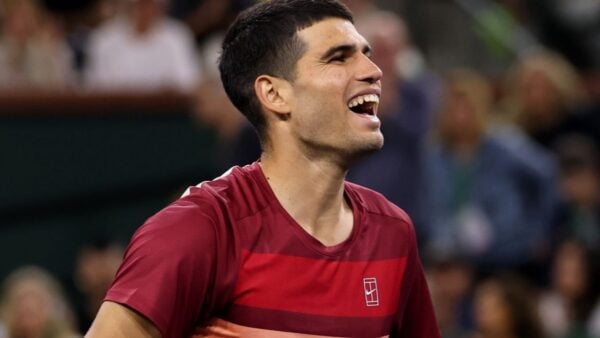(In Images) Jelena Ostapenko Lifts Skirt While Getting Questioned About All-White Wimbledon Dress Code
The Wimbledon dress code is under a monitor for the last couple of days, and Jelena Ostapenko's actions caused a moment of tension.

Jelena Ostapenko lifted her skirt causing a moment of tension (via TalkSport)
🔍 Explore this post with:
Jelena Ostapenko appeared visibly confused during her Wimbledon women’s doubles match when an umpire checked her outfit. The 28-year-old Latvian was set to play alongside partner Hsieh Su-wei on Court 14. Wimbledon enforces a strict all-white dress code, though some rules were updated in 2023. Female players are now permitted to wear dark undershorts for comfort during menstruation.
British umpire Jamie Crowson approached Ostapenko before the match began. She reacted with visible frustration, gesturing with her hands and looking puzzled. In response, Ostapenko lifted her skirt to reveal green shorts, which were within the updated guidelines. The brief exchange caused a moment of tension before the match resumed.
What's the problem with Ostapenko's outfit? 😂😂 pic.twitter.com/RPjwEzd4Oy
— LorenaPopa 🕵️♀️🎾 (@popalorena) July 4, 2025
Ostapenko, a former French Open champion, quickly moved past the incident. She and her partner, Hsieh, faced Marta Kostyuk and Elena-Gabriela Ruse in the second round. The early interruption didn’t affect their focus on court. The pair regrouped after losing the first set.
They went on to dominate the next two sets with scores of 6-2, 6-2. Despite the confusion around her outfit, Ostapenko delivered a strong performance. With Hsieh’s experience and their growing momentum, they advanced to the next round with a convincing win.
Jelena Ostapenko knocked out of the first round at Wimbledon
Sonay Kartal began her Wimbledon run with a strong win over 20th seed Jelena Ostapenko. The British No. 3 claimed the first-round match 7-5, 2-6, 6-2 in just under two hours. She managed to handle Ostapenko’s power and used the Latvian’s limited movement to her advantage. It marked Kartal’s second top-25 win this summer.

The 23-year-old hopes to build on last year’s third-round finish. This year, she faces Viktoriya Tomova next, after Ons Jabeur withdrew. Just a year ago, Kartal was ranked outside the top 290, but now she sits just outside the top 50. She credits her rise to smart scheduling after her success in 2023.
In the opening set, Kartal came from 1-4 down. She saved three set points and won back-to-back breaks to turn the tide. Her confident forehand sealed the set, despite fears of a possible injury recurrence. However, Ostapenko responded strongly in the second, hitting 15 winners to force a deciding third set.
Kartal took control early in the final set. She used variety, including drop shots, to break Ostapenko’s rhythm. After an early net cord helped Kartal gain the lead, she won five straight games. Despite one missed chance to close, she served out the win on her second opportunity to reach round two.
Why have so many seeds fallen at Wimbledon?
Wimbledon’s early rounds have delivered major surprises, with an unprecedented number of seeded players knocked out. By the end of Thursday, 36 seeds had exited, surpassing the 2020 French Open’s previous record of 35. The early eliminations of stars like Coco Gauff and Alexander Zverev have left both the men’s and women’s draws wide open.

Eight top-10 seeds lost in the first round alone — a first in any major since the Open era began in 1968. Only world No. 1 Aryna Sabalenka from the top five women advanced to the third round, marking just the second time this has happened in Open era history. Four top-10 players exited in the opening round for only the third time in the past 25 years, and Britain’s Jack Draper added to the chaos by falling in the second round.
Players also battled extreme conditions, as Wimbledon saw its hottest-ever opening day with temperatures topping 30°C. Ice packs, cold towels, and hydration were provided, but the heat still impacted performance. Cameron Norrie admitted the high temperatures were a shock, and some athletes voiced frustration over how the dry grass affected ball behavior, making rallies longer and matches more draining.
Groundsman Neil Stubley acknowledged the heat slowed the courts, but disagreed with claims about inconsistent bounce. Still, players remain concerned about the short grass-court season, which lasts under 50 days.
It overlaps with the tail end of the clay season, leaving little room for adjustment. Coco Gauff had just one grass tournament before Wimbledon, and several players, including Casper Ruud and Alex de Minaur, have criticized the tight schedule and its toll on performance.
Also Read: John McEnroe Reveals Whether Novak Djokovic Will Retire from Tennis if He Wins Wimbledon







